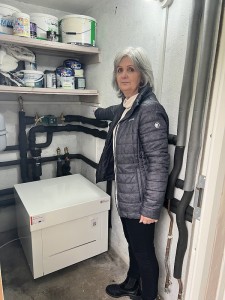The first resident in the Cornish village of Stithians has had their ground source heat pump connected to an ambient heat network that will draw energy from under the street.
The ‘Heat the Streets’ project, with a shared ground array retrospectively installed in a public highway, is thought to be a world first. The project is run by Kensa Utilities and has €3.4 million funding from the European Regional Development Fund.
Each home in Heat the Streets will swap oil or LPG fossil fuels for its own Kensa ground source heat pump, which provide the property’s heating and hot water year round. Homeowners will pay a monthly standing charge to access the heat network, much like the existing gas connection fee.
The in-road ground source heat pump network, also known as Networked Heat Pumps, in Collins Parc, Stithians, will consist of 42 boreholes, drilled to an average depth of 106m. It allows homeowners to utilise the heat from the ground to keep their houses warm and reduce carbon emissions. The infrastructure emulates the existing gas grid and has been designed to accommodate future connections, allowing households who were not ready to change their heating system to connect at a later date.
 Unlike traditional district heating, there is no need for a central plant, no heat loss around the network, and customers can still change their energy provider at will, promoting energy independence.
Unlike traditional district heating, there is no need for a central plant, no heat loss around the network, and customers can still change their energy provider at will, promoting energy independence.
Wouter Thijssen, Kensa Utilities managing director, said: “It’s fantastic to have the first heat pump up and running on this landmark project which provides a blueprint for the decarbonisation of heating in the UK. Our model replicates the gas network with a pipe in the ground, a flat rate standing charge to consumers and a little white box in the house.
“Just as Burton Upon Trent was the first UK town to convert to natural gas in 1968 – at the time a cheaper, better, cleaner fuel than towns gas – we believe Stithians is the first UK town to convert to the 21st-century equivalent: networked heat pumps. Residents will have access to a network that will provide cheaper and cleaner heat for 100 years to come”.
Some locals have already been connected to a parallel scheme in Stithians which involves drilling a borehole into their front drive. Jackie Barson, a resident of Stithians is already connected, said: “I am happy with it. It’s smart and efficient. It’ll take a few weeks to fully get to grips with the operation, but I have no regrets. I do know there are other residents who are disappointed they’re not part of the project.”
Kensa says that to make projects like Heat The Streets easily replicable across the country, effective zoning and the granting of statutory rights for heat networks are crucial. The water, gas, electricity, communications and energy industries enjoy statutory rights of access on to private land to lay pipes, wires, cables and other service infrastructure. Granting statutory rights for heat networks would provide a legal framework for their development and ensure their stability and longevity, reducing costs and speeding up deployment time.